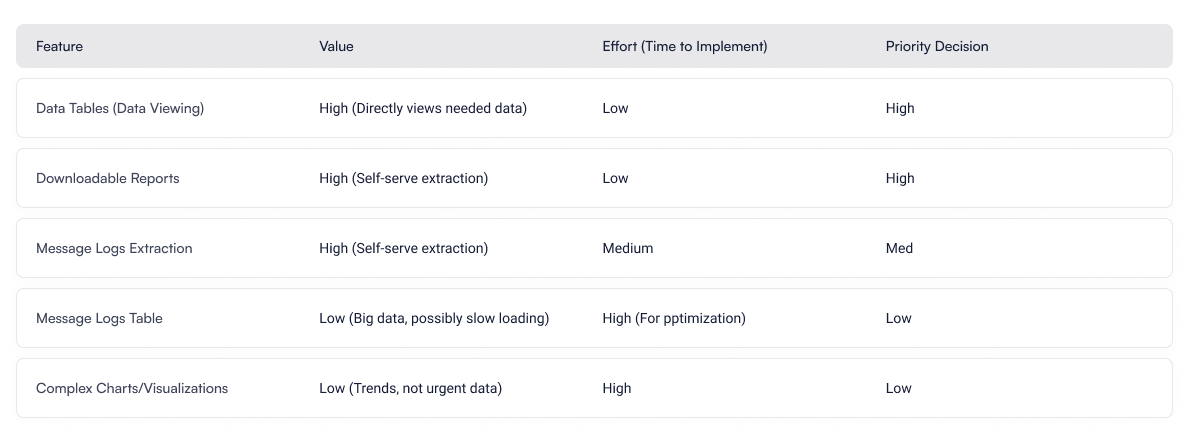Dashboard Redesign and Conflict Resolution
The Core Problem and Initial Constraint (Pre-Requirements/Design)
The project began to fix a major user problem: the existing dashboard contained the necessary data, but users found the presentation so poor they would rather request that the data be extracted by support personnel. Data showed that 70% of users relied on customer support for this information during the 3rd Quarter of 2024, indicating a significant usability problem. My objective was to lead the effort to revamp the dashboard to provide significant and useful information.
The initial constraint created the first conflict: a one-month delivery timeline, with only one week allotted for design. Our standard process requires three weeks for proper iteration. Development was scheduled to start in 2nd Quarter 2024.
Requirements
Conflict: The Scrum Master insisted the one-week design timeline was firm. Rushing this phase would guarantee the same usability failure the project aimed to fix.
Action & Resolution: I refused the unrealistic timeline. I engaged stakeholders and my manager, framing the issue around business risk:
“The risk is not in delaying; the risk is in rushing a flawed product. We are tackling a 70% support reliance issue. If we ship a feature that is poorly designed, we will generate more questions, increase the support workload, and ultimately waste the entire development investment. We must secure time for three proper design iterations.”
My insistence led to a compromise. Stakeholders granted a two-week design period. To meet the deadline with quality, the team maximized effort and worked double time to complete three full design iterations. This secured the quality needed and agreed to a revised timeline, delaying the start of 2nd Quarter 2024 development slightly.
Scoping and Hand-off
Conflict: After design was complete, the development team estimated that implementing the full scope of the approved design would take 3 months, far exceeding the remaining schedule.
Action & Resolution: I led the scoping and hand-off session, focusing on collaboration with the developers to mutually understand the design's value and jointly determine what we could realistically deliver in the time remaining. We prioritized value using a Time vs. Effort analysis:
We collectively agreed on a stripped-down design scope. I clarified that while I was accountable for design quality, adjustments to the development schedule were the team's responsibility to communicate. This collaborative approach secured team buy-in and focused development on high-impact, achievable features.
Development
Conflict: One week before the scheduled launch date, during User Acceptance Testing (UAT), I found the output did not meet professional standards. Specifically, the UI was broken on some devices, and UI components were inconsistent across different pages. The development lead advocated for launching as-is despite these severe quality gaps.
Action & Resolution: I escalated the quality concern immediately, overriding the pushback. I formally recommended moving the deadline by one month, clearly stating my accountability:
"I appreciate the development effort, but the current output represents a professional failure to deliver on our commitment to quality. The UI is broken and inconsistent; launching now guarantees failure. I formally recommend we move the deadline by one month to ensure the remaining quality fixes are implemented correctly. I will not sign off on a sub-standard product.”
I stood firm. The deadline moved. The delay ensured correct implementation.
Project Outcome
The dashboard was delivered one month later than originally planned. The commitment to quality was validated: we achieved a confirmed 10% reduction in customer support requests in the first week.
Systemic Alignment and Design System Creation
Conflict: During post-launch debriefing (conducted in the 3rd quarter), a systemic conflict was revealed: my team's output contributed to miscommunication. The lack of a source of truth meant new developers struggled to implement UI components correctly (leading to the broken UI and inconsistencies seen in UAT).
Action & Resolution: I leveraged this data to immediately champion and lead a 3rd Quarter 2025 initiative to create a comprehensive Design System. This project provided a definitive source of truth for all UI components and design standards, proactively solving the internal conflict and ensuring better technical alignment for future projects.




